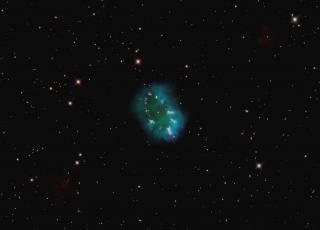Bibcode
Corradi, R. L. M.; Leal-Ferreira, M. L.; Gonçalves, D. R.; Monteiro, H.
Bibliographical reference
Astronomy and Astrophysics, Volume 560, id.A102, 10 pp.
Advertised on:
12
2013
Journal
Citations
22
Refereed citations
19
Description
Aims: Optical integral-field spectroscopy was used to investigate
the planetary nebula NGC 3242. We analysed the main
morphological components of this source, including its knots, but not
the halo. In addition to revealing the properties of the physical and
chemical nature of this nebula, we also provide reliable spatially
resolved constraints that can be used for future photoionisation
modelling of the nebula. The latter is ultimately necessary to obtain a
fully self-consistent 3D picture of the physical and chemical properties
of the object. Methods: The observations were obtained with the
VIMOS instrument attached to VLT-UT3. Maps and values for specific
morphological zones for the detected emission-lines were obtained and
analysed with routines developed by the authors to derive physical and
chemical conditions of the ionised gas in a 2D fashion. Results:
We obtained spatially resolved maps and mean values of the electron
densities, temperatures, and chemical abundances for specific
morphological structures in NGC 3242. These results show the
pixel-to-pixel variations of the the small- and large-scale structures
of the source. These diagnostic maps provide information free from the
biases introduced by traditional single long-slit observations.
Conclusions: In general, our results are consistent with a uniform
abundance distribution for the object, whether we look at abundance maps
or integrated fluxes from specified morphological structures. The
results indicate that special care should be taken with the calibration
of the data and that only data with extremely good signal-to-noise ratio
and spectral coverage should be used to ensure the detection of possible
spatial variations.
Based on observations collected at the European Southern Observatory,
Chile, via programme ESO No. 074.D-0425(A).
Related projects

Bipolar Nebulae
This project has three major objectives: 1) To determine the physico-chemical characteristics of bipolar planetary nebulae and symbiotic nebulae, to help understanding the origin of bipolarity and to test theoretical models, mainly models with binary central stars, aimed at explaining the observed morphology and kinematics. 2) To study the low
Antonio
Mampaso Recio